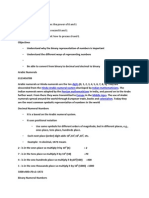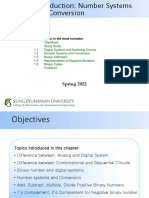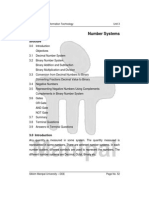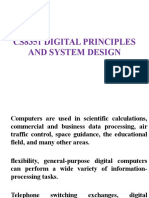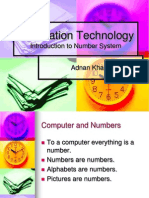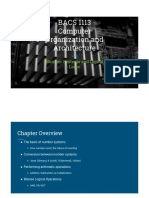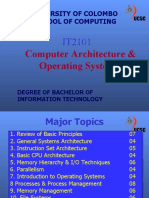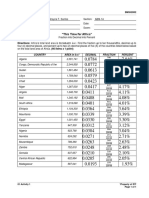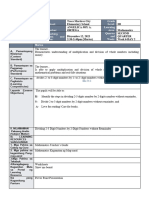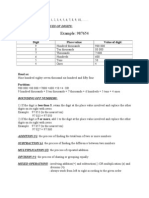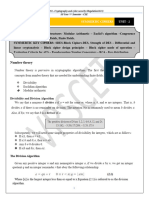SOUTH EAST ASIAN INSTITUTE OF TECHNOLOGY, INC.
National Highway, Crossing Rubber, Tupi, South Cotabato
COLLEGE OF INFORMATION AND COMMUNICATION TECHNOLOGY
___________________________________________________
IT 121: Introduction to Computing
SOUTH EAST ASIAN INSTITUTE OF TECHNOLOGY, INC.
Page 1 of 9
� LEARNING MODULE
FOR
IT 121: INTRODUCTION TO COMPUTING
_____________________________________________________
WEEK 5
COURSE OUTLINE
COURSE CODE : IT 121
TITLE : Introduction to Computing
TARGET POPULATION : All BS Information Technology Students
INSTRUCTOR : HERNIE B. DEDURO
IT 121: Introduction to Computing
SOUTH EAST ASIAN INSTITUTE OF TECHNOLOGY, INC.
Page 2 of 9
�Overview:
Computers are everywhere: at work, at school, and at home. Computers are a primary means of local and
global communications for billions of people. Through computers, society has instant access to information from
around the globe. This module presents the knowledge you need to be computer literate. The course acquaints
students to discover different and innovative ways of using various technology and learn how computing is applied
creatively to solve problems. Students will finish this course with a solid understanding of computers, how to use
computers, and how to access information on the Web.
Objectives:
General Objective
Differentiate among various styles of system units on desktop computers, notebook computers, and
mobile devices.
Describe the control unit and arithmetic logic unit components of a processor, and explain the four
steps in a machine cycle.
Evaluate the number system.
Define a bit and describe how a series of bits represents data.
Distinguish the importance of number systems in relation to computers and its application.
Instruction to the Learner
Each chapter in this module contains a major lesson involving the introduction to computers and learn
how computing is applied creatively to solve problems. The units are characterized by continuity, and are arranged
in such a manner that the present unit is related to the next unit. For this reason, you are advised to read this
module. After each unit, there are exercises to be given. Submission of task given will be submitted by the agreed
deadline.
IT 121: Introduction to Computing
SOUTH EAST ASIAN INSTITUTE OF TECHNOLOGY, INC.
Page 3 of 9
� Data Representation in Computer System
Most computers are digital and the computer can only understand machine language and does not recognize
letters as letters of the alphabet; it sees the letters as a series of 0’s and 1’s called the binary language. A
computer circuit represents the 0 or the 1 electronically by the presence or absence of an electrical charge.
The binary system uses two unique digits (0 and 1).
o Bits and bytes - Eight bits grouped together as a unit are called a byte. A byte represents a single
character in the computer. Example is the uppercase character ‘A’ is represented in ASCII as 0100
0001 in binary.
o ASCII (American Standard Code for Information Interchange) is the most widely used coding scheme
to represent data and for converting.
BASE – Base is a number of digits in a number system.
Commonly used bases of number system
o Decimal - Base 10 (Decimal) — Represent any number using 10 digits [0–9]
Decimal Binary Octal Hexadecimal
0 0000 000 0
1 0001 000 1
2 0010 001 2
3 0011 002 3
4 0100 003 4
5 0101 004 5
6 0110 005 6
7 0111 006 7
8 1000 007 8
9 1001 010 9
10 1010 011 A
11 1011 012 B
12 1100 013 C
13 1101 014 D
14 1110 016 E
15 1111 017 F
IT 121: Introduction to Computing
SOUTH EAST ASIAN INSTITUTE OF TECHNOLOGY, INC.
Page 4 of 9
�Binary Number System
Binary (Base 2)
The binary system only requires two symbols. 0 and 1 are used. The columns in binary represent:
Binary exponential place
values
27 26 25 24 23 22 21 20
128s 64s 32s 16s 8s 4s 2s
Binary place values
1 units
e.g. In the binary number
0 0 0 1 0 1
0 1
is equal to 16 + 4 +1 = 21 in decimal.
IT 121: Introduction to Computing
SOUTH EAST ASIAN INSTITUTE OF TECHNOLOGY, INC.
Page 5 of 9
�Try the following. Show your working: Example:
The number 1110 = 8+4+2 = 14 decimal
1. 0110 4+2=6
2. 1001 8+1=9
3. 0101 4+1=5
4. 1111 8+4+2+1=15
5. 0010 2=2
6. 1101 8+4+1=13
Try to learn the following powers of 2 by heart
28 = 256
210 =1024 = 1k
216 =65536=64k
220 =1048576= 1 MB
224 = 16 MB
230 = 1 GB
232 = 4 GB
240 = 1 TB = 1 Terabyte
Binary Addition:
Four Rules for addition:
0+0=0
0+1=1
1+0=1
1 + 1 = 10= 0 carry 1
Example 1:
The column by column addition of binary is applied 1+0+1 = 10 = 0 with a carry of 1
below in details. Let us consider the addition of
11101 and 11011. 1+1+0 = 10 = 10 = 0 with a carry of 1
1+1+1= 10+1 = 11= 1 with a carry of 1
29
1 +1 +1 = 11
27
Note carefully that 10 + 1 = 11, which is equivalent
56 to two + one = three (the next binary number after
10)
The above sum is carried out by following step
Thus the required result is 111000.
1 + 1 = 10 = 0 with a carry of 1.
IT 121: Introduction to Computing
SOUTH EAST ASIAN INSTITUTE OF TECHNOLOGY, INC.
Page 6 of 9
�Example 2:
Addition of 01010101 (decimal=85) and 01110100 (decimal=116):
Example 2:
Binary Subtraction
The subtraction of the binary digit depends on the
four basic operations
0–0=0
1–0=1
1–1=0
10 – 1 = 1 The above subtraction is carried out through the
The above first three operations are easy to following steps.
understand as they are identical to decimal 0–0=0
subtraction. The fourth operation can be
understood with the logic two minus one is one. For 0 – 1 = 1, taking borrow 1 and then 10 – 1 = 1
For a binary number with two or more digits, the For 1 – 0, since 1 has already been given, it becomes
subtraction is carried out column by column as in 0–0=0
decimal subtraction. Also, sometimes one has to
1–1=0
borrow from the next higher column. Consider the
following example. Therefore the result is 0010.
Example 2:
Subtraction of 100001 (dec=33) & 11111 (dec=31) ; 11100 (dec=28) & 1111 (dec=15):
Multiplication
The product of two N-bit numbers requires 2N bits to contain all
possible values. If the precision of the two two's-complement
operands is doubled before the multiplication, direct multiplication (discarding any excess bits beyond that
precision) will provide the correct result.
Decimal Binary
0x0= 0 0
0x1= 0 0
1x0= 0 0
1x1= 1 1
IT 121: Introduction to Computing
SOUTH EAST ASIAN INSTITUTE OF TECHNOLOGY, INC.
Page 2 of 9
�In binary multiplication,
It’s pretty much the same with decimal number multiplication.
For example. Let's multiply 12 by 15, which in binary will be 1100 by 1111.
12 x 15
First, you take the first digit from 1111 and multiply it by 1100, which gives the same
number:
1100 multiplied by the first digit
Now we're going to repeat the same process with each digit, shifting to the left with each
of them, getting this descending series of 1100s:
Products ready to be added
Finally, we just need to add the numbers. This can be a little tricky when you add
several 1's in a row.
Once we reach the column with the two consecutive 1's, remember that the result is 0 and we
carry a 1 to the next column.
Add two 1s, carry a 1 to the next column
In the next column, we need to add the numbers by pairs. The first two 1's
will add up to 0, carry a 1, then, the result 0 plus the 1 will add up to 1.
The result is 180
Keep track of
the result of
each individual
addition
We keep repeating
the same process until we finish all the addition:
We can check that 12 multiplied by 15 is 180, which in binary is 10110100.
IT 121: Introduction to Computing
SOUTH EAST ASIAN INSTITUTE OF TECHNOLOGY, INC.
Page 2 of 9
�Example 2:
15
Multiply binary numbers 1111 and 111
X 17
Binary division
The rule of binary division is
1) Started from the left side to the dividend. 2) Perform a series of subtraction.
3) If subtraction is possible than put 1 in the quotient and105subtract the divisor
from the corresponding digits of dividend. 4) If subtraction is not possible record 0 in the
quotient. 5) Bring down the next digit to the remainder
digits.
Division table
0/0= divided by zero error
0/1=0
1/0= divided by zero error
1/1=1
Example
Divided 1000012 by 1102
The result is dividing 3310 (1000012) by 610 (1102) gives quotient of
510 (1012) and remainder is 310 (112)
Another example for
Computing Binary division.
IT 121: Introduction to Computing
SOUTH EAST ASIAN INSTITUTE OF TECHNOLOGY, INC.
Page 3 of 9


